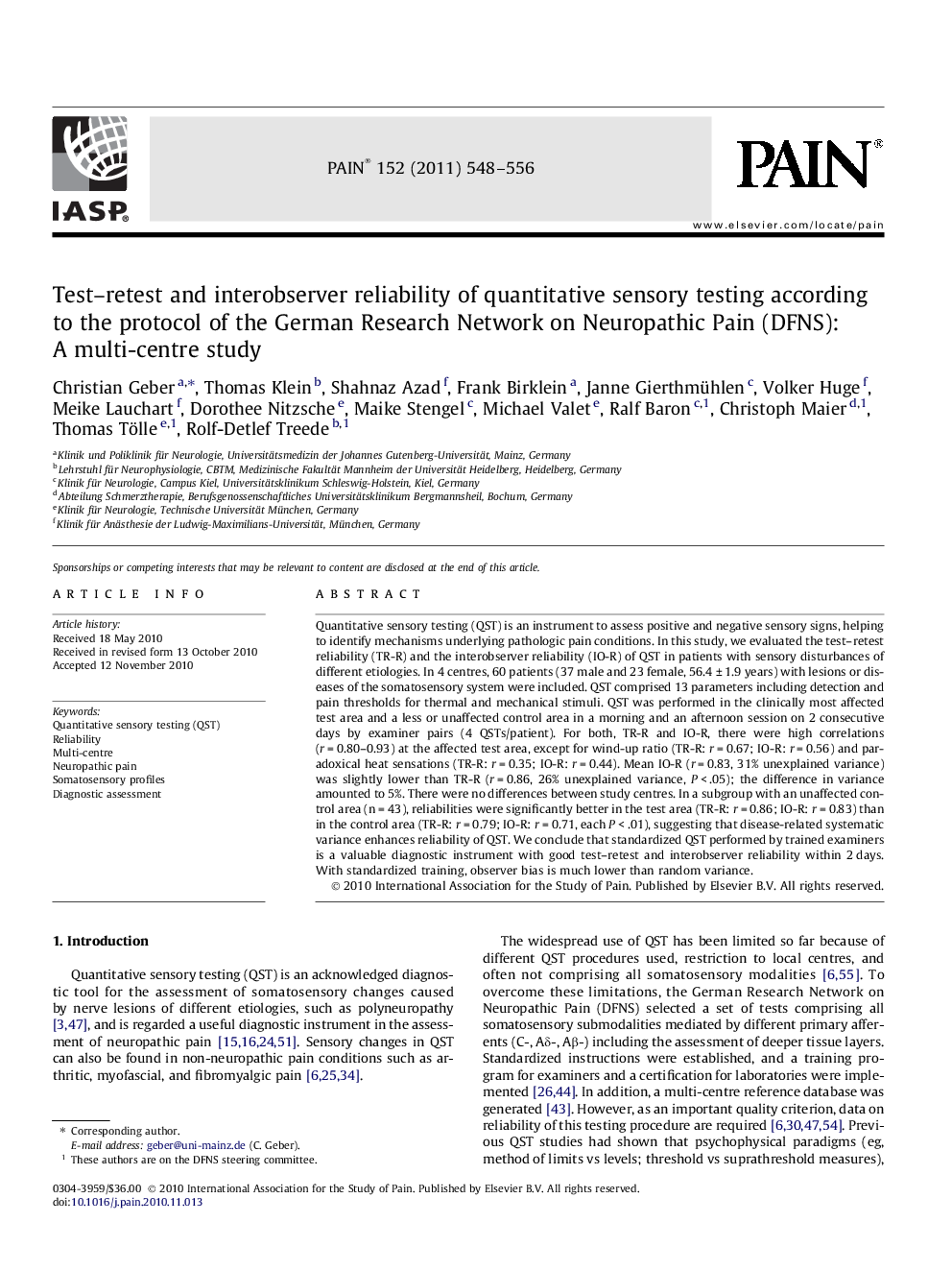| کد مقاله | کد نشریه | سال انتشار | مقاله انگلیسی | نسخه تمام متن |
|---|---|---|---|---|
| 10451111 | 918389 | 2011 | 9 صفحه PDF | دانلود رایگان |
عنوان انگلیسی مقاله ISI
Test-retest and interobserver reliability of quantitative sensory testing according to the protocol of the German Research Network on Neuropathic Pain (DFNS): A multi-centre study
دانلود مقاله + سفارش ترجمه
دانلود مقاله ISI انگلیسی
رایگان برای ایرانیان
کلمات کلیدی
موضوعات مرتبط
علوم زیستی و بیوفناوری
علم عصب شناسی
علوم اعصاب سلولی و مولکولی
پیش نمایش صفحه اول مقاله

چکیده انگلیسی
Quantitative sensory testing (QST) is an instrument to assess positive and negative sensory signs, helping to identify mechanisms underlying pathologic pain conditions. In this study, we evaluated the test-retest reliability (TR-R) and the interobserver reliability (IO-R) of QST in patients with sensory disturbances of different etiologies. In 4 centres, 60 patients (37 male and 23 female, 56.4 ± 1.9 years) with lesions or diseases of the somatosensory system were included. QST comprised 13 parameters including detection and pain thresholds for thermal and mechanical stimuli. QST was performed in the clinically most affected test area and a less or unaffected control area in a morning and an afternoon session on 2 consecutive days by examiner pairs (4 QSTs/patient). For both, TR-R and IO-R, there were high correlations (r = 0.80-0.93) at the affected test area, except for wind-up ratio (TR-R: r = 0.67; IO-R: r = 0.56) and paradoxical heat sensations (TR-R: r = 0.35; IO-R: r = 0.44). Mean IO-R (r = 0.83, 31% unexplained variance) was slightly lower than TR-R (r = 0.86, 26% unexplained variance, P < .05); the difference in variance amounted to 5%. There were no differences between study centres. In a subgroup with an unaffected control area (n = 43), reliabilities were significantly better in the test area (TR-R: r = 0.86; IO-R: r = 0.83) than in the control area (TR-R: r = 0.79; IO-R: r = 0.71, each P < .01), suggesting that disease-related systematic variance enhances reliability of QST. We conclude that standardized QST performed by trained examiners is a valuable diagnostic instrument with good test-retest and interobserver reliability within 2 days. With standardized training, observer bias is much lower than random variance.
ناشر
Database: Elsevier - ScienceDirect (ساینس دایرکت)
Journal: PAIN® - Volume 152, Issue 3, March 2011, Pages 548-556
Journal: PAIN® - Volume 152, Issue 3, March 2011, Pages 548-556
نویسندگان
Christian Geber, Thomas Klein, Shahnaz Azad, Frank Birklein, Janne Gierthmühlen, Volker Huge, Meike Lauchart, Dorothee Nitzsche, Maike Stengel, Michael Valet, Ralf Baron, Christoph Maier, Thomas Tölle, Rolf-Detlef Treede,